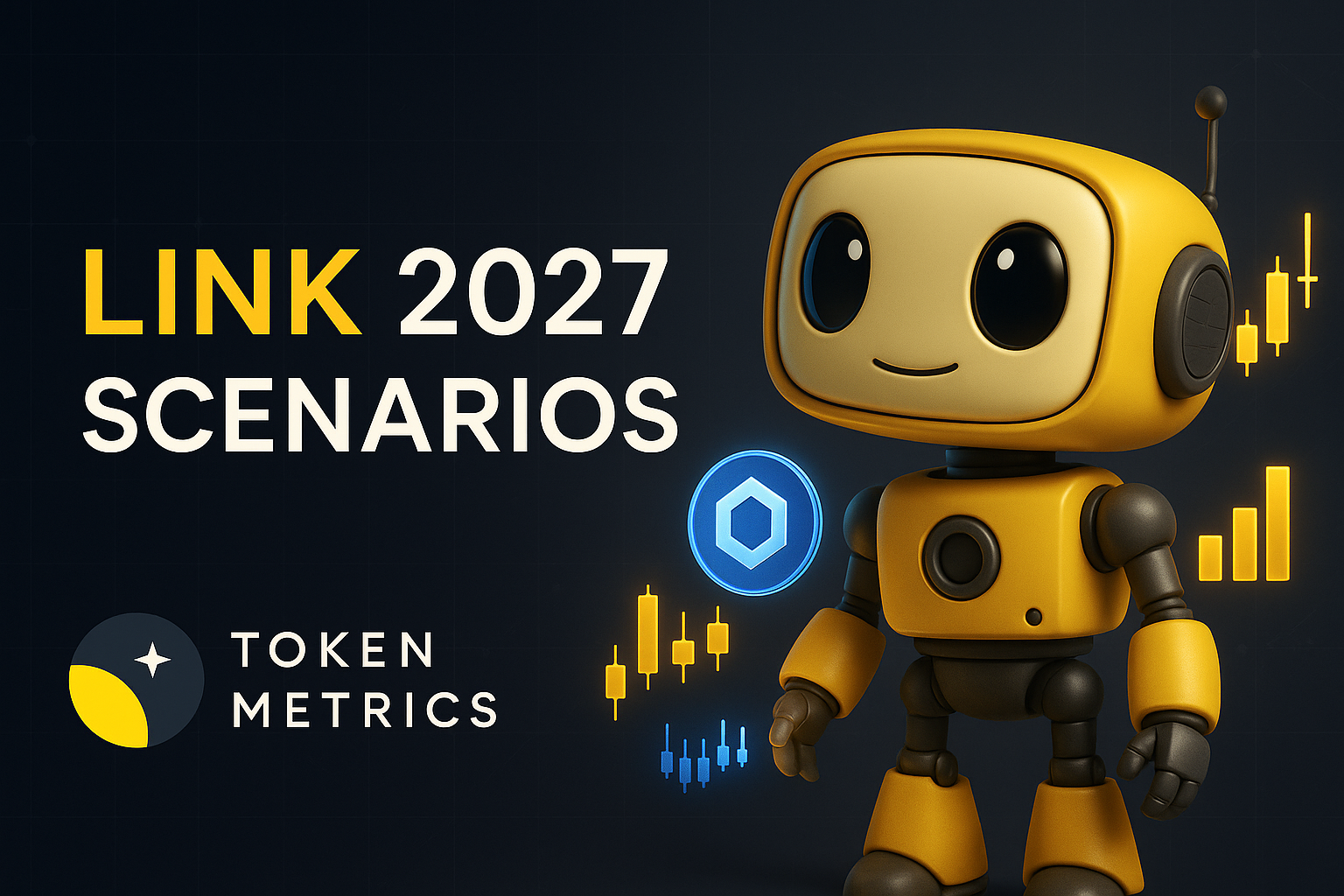Top Crypto Trading Platforms in 2025







%201.svg)
%201.svg)
Big news: We’re cranking up the heat on AI-driven crypto analytics with the launch of the Token Metrics API and our official SDK (Software Development Kit). This isn’t just an upgrade – it's a quantum leap, giving traders, hedge funds, developers, and institutions direct access to cutting-edge market intelligence, trading signals, and predictive analytics.
Crypto markets move fast, and having real-time, AI-powered insights can be the difference between catching the next big trend or getting left behind. Until now, traders and quants have been wrestling with scattered data, delayed reporting, and a lack of truly predictive analytics. Not anymore.
The Token Metrics API delivers 32+ high-performance endpoints packed with powerful AI-driven insights right into your lap, including:
Getting started with the Token Metrics API is simple:
At Token Metrics, we believe data should be decentralized, predictive, and actionable.
The Token Metrics API & SDK bring next-gen AI-powered crypto intelligence to anyone looking to trade smarter, build better, and stay ahead of the curve. With our official SDK, developers can plug these insights into their own trading bots, dashboards, and research tools – no need to reinvent the wheel.
%201.svg)
%201.svg)
Infrastructure protocols become more valuable as the crypto ecosystem scales and relies on robust middleware. Chainlink provides critical oracle infrastructure where proven utility and deep integrations drive long-term value over retail speculation. Increasing institutional adoption raises demand for professional-grade data delivery and security.
Token Metrics projections for LINK below span multiple total market cap scenarios from conservative to aggressive. Each tier assumes different levels of infrastructure demand as crypto evolves from speculative markets to institutional-grade systems. These bands frame LINK's potential outcomes into 2027.

Disclosure
Educational purposes only, not financial advice. Crypto is volatile, do your own research and manage risk.
How to read it: Each band blends cycle analogues and market-cap share math with TA guardrails. Base assumes steady adoption and neutral or positive macro. Moon layers in a liquidity boom. Bear assumes muted flows and tighter liquidity.
TM Agent baseline: Token Metrics lead metric for Chainlink, cashtag $LINK, is a TM Grade of 23.31%, which translates to a Sell, and the trading signal is bearish, indicating short-term downward momentum. This means Token Metrics currently does not endorse $LINK as a long-term buy at current conditions.
Live details: Chainlink Token Details
Affiliate Disclosure: We may earn a commission from qualifying purchases made via this link, at no extra cost to you.
Token Metrics scenarios span four market cap tiers, each representing different levels of crypto market maturity and liquidity:
8T: At an 8 trillion dollar total crypto market cap, LINK projects to $26.10 in bear conditions, $30.65 in the base case, and $35.20 in bullish scenarios.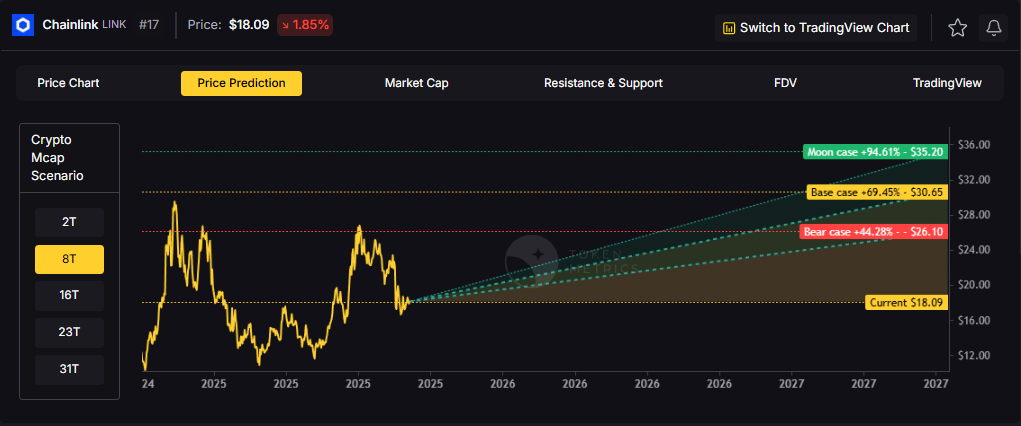
16T: Doubling the market to 16 trillion expands the range to $42.64 (bear), $56.29 (base), and $69.95 (moon).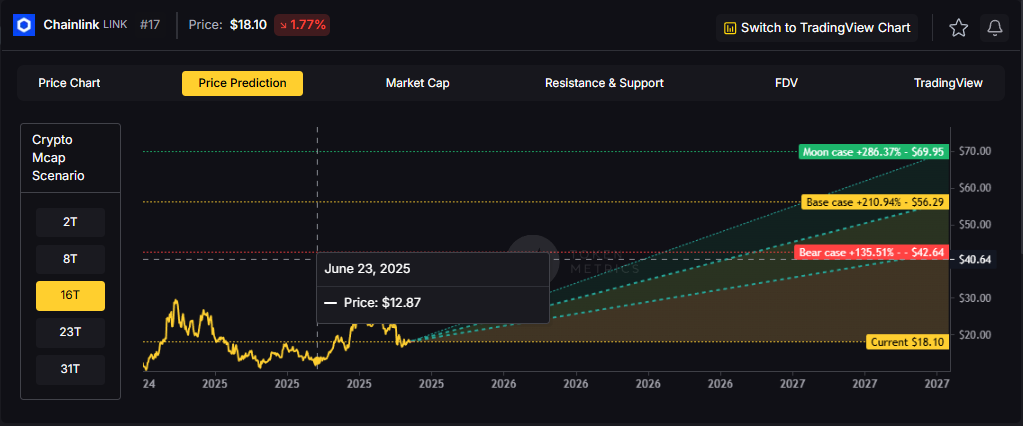
23T: At 23 trillion, the scenarios show $59.18, $81.94, and $104.70 respectively.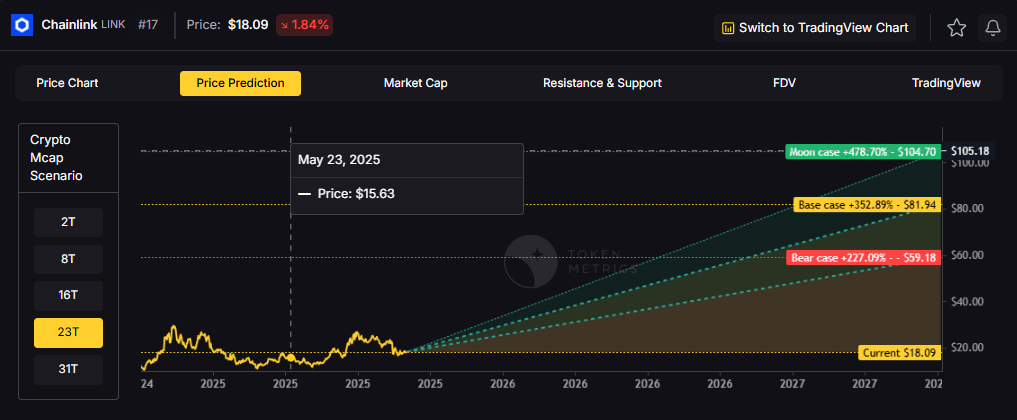
31T: In the maximum liquidity scenario of 31 trillion, LINK could reach $75.71 (bear), $107.58 (base), or $139.44 (moon).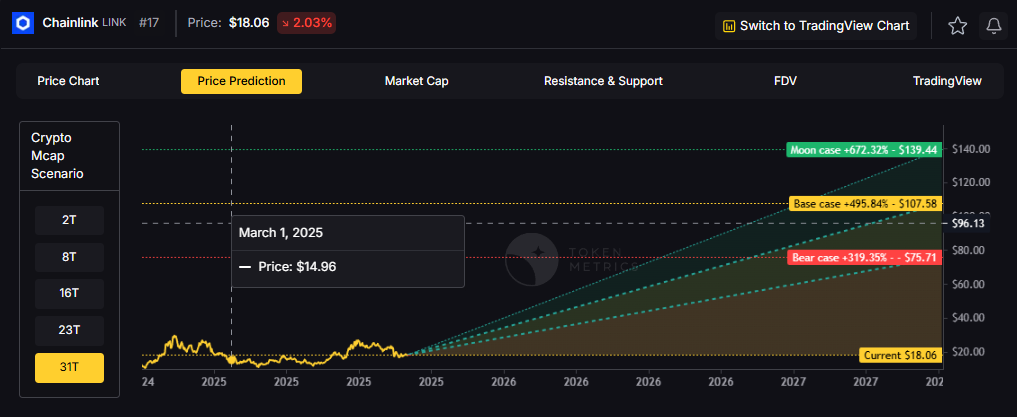
Chainlink represents one opportunity among hundreds in crypto markets. Token Metrics Indices bundle LINK with top one hundred assets for systematic exposure to the strongest projects. Single tokens face idiosyncratic risks that diversified baskets mitigate.
Historical index performance demonstrates the value of systematic diversification versus concentrated positions.
Chainlink is a decentralized oracle network that connects smart contracts to real-world data and systems. It enables secure retrieval and verification of off-chain information, supports computation, and integrates across multiple blockchains. As adoption grows, Chainlink serves as critical infrastructure for reliable data feeds and automation.
The LINK token is used to pay node operators and secure the network’s services. Common use cases include DeFi price feeds, insurance, and enterprise integrations, with CCIP extending cross-chain messaging and token transfers.
Vision: Chainlink aims to create a decentralized, secure, and reliable network for connecting smart contracts with real-world data and systems. Its vision is to become the standard for how blockchains interact with external environments, enabling trust-minimized automation across industries.
Problem: Smart contracts cannot natively access data outside their blockchain, limiting their functionality. Relying on centralized oracles introduces single points of failure and undermines the security and decentralization of blockchain applications. This creates a critical need for a trustless, tamper-proof way to bring real-world information onto blockchains.
Solution: Chainlink solves this by operating a decentralized network of node operators that fetch, aggregate, and deliver data from off-chain sources to smart contracts. It uses cryptographic proofs, reputation systems, and economic incentives to ensure data integrity. The network supports various data types and computation tasks, allowing developers to build complex, data-driven decentralized applications.
Market Analysis: Chainlink is a market leader in the oracle space and a key infrastructure component in the broader blockchain ecosystem, particularly within Ethereum and other smart contract platforms. It faces competition from emerging oracle networks like Band Protocol and API3, but maintains a strong first-mover advantage and widespread integration across DeFi, NFTs, and enterprise blockchain solutions. Adoption is driven by developer activity, partnerships with major blockchain projects, and demand for secure data feeds. Key risks include technological shifts, regulatory scrutiny on data providers, and execution challenges in scaling decentralized oracle networks. As smart contract usage grows, so does the potential for oracle services, positioning Chainlink at the center of a critical niche, though its success depends on maintaining security and decentralization over time.
Fundamental Grade: 74.58% (Community 81%, Tokenomics 100%, Exchange 100%, VC —, DeFi Scanner 17%).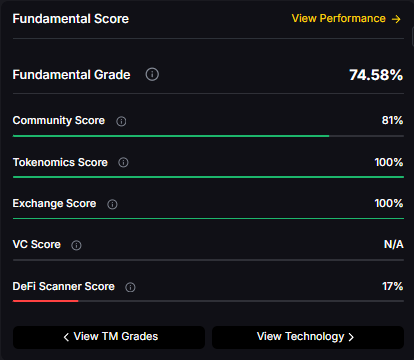
Technology Grade: 88.50% (Activity 81%, Repository 72%, Collaboration 100%, Security 86%, DeFi Scanner 17%).
Can LINK reach $100?
Yes. Based on the scenarios, LINK could reach $100+ in the 23T moon case. The 23T tier projects $104.70 in the moon case. Not financial advice.
What price could LINK reach in the moon case?
Moon case projections range from $35.20 at 8T to $139.44 at 31T. These scenarios assume maximum liquidity expansion and strong Chainlink adoption. Not financial advice.
Should I buy LINK now or wait?
Timing depends on risk tolerance and macro outlook. Current price of $18.09 sits below the 8T bear case in the scenarios. Dollar-cost averaging may reduce timing risk. Not financial advice.
Track live grades and signals: Token Details
Want exposure? Buy LINK on MEXC
Disclosure
Educational purposes only, not financial advice. Crypto is volatile, do your own research and manage risk.
Discover the full potential of your crypto research and portfolio management with Token Metrics. Our ratings combine AI-driven analytics, on-chain data, and decades of investing expertise—giving you the edge to navigate fast-changing markets. Try our platform to access scenario-based price targets, token grades, indices, and more for institutional and individual investors. Token Metrics is your research partner through every crypto market cycle.
%201.svg)
%201.svg)
The crypto market is tilting bullish into 2026 as liquidity, infrastructure, and participation improve across the board. Clearer rules and standards are reshaping the classic four-year cycle, flows can arrive earlier, and strength can persist longer than in prior expansions.
Institutional access is widening through ETFs and custody, while L2 scaling and real-world integrations help sustain on‑chain activity. This healthier backdrop frames our scenario work for HYPE. The ranges below reflect different total crypto market sizes and the share Hyperliquid could capture under each regime.
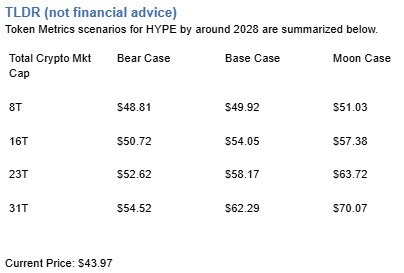
Disclosure
Educational purposes only, not financial advice. Crypto is volatile, do your own research and manage risk.
How to read it: Each band blends cycle analogues and market-cap share math with TA guardrails. Base assumes steady adoption and neutral or positive macro. Moon layers in a liquidity boom. Bear assumes muted flows and tighter liquidity.
TM Agent baseline: Token Metrics TM Grade is 73.9%, a Buy, and the trading signal is bearish, indicating short-term downward momentum. This means Token Metrics judges HYPE as fundamentally attractive over the long term, while near-term momentum is negative and may limit rallies.
Live details: Hyperliquid Token Details
Affiliate Disclosure: We may earn a commission from qualifying purchases made via this link, at no extra cost to you.
Scenario Analysis
Token Metrics scenarios span four market cap tiers, each representing different levels of crypto market maturity and liquidity:
8T: At an 8 trillion dollar total crypto market cap, HYPE projects to $48.81 in bear conditions, $49.92 in the base case, and $51.03 in bullish scenarios.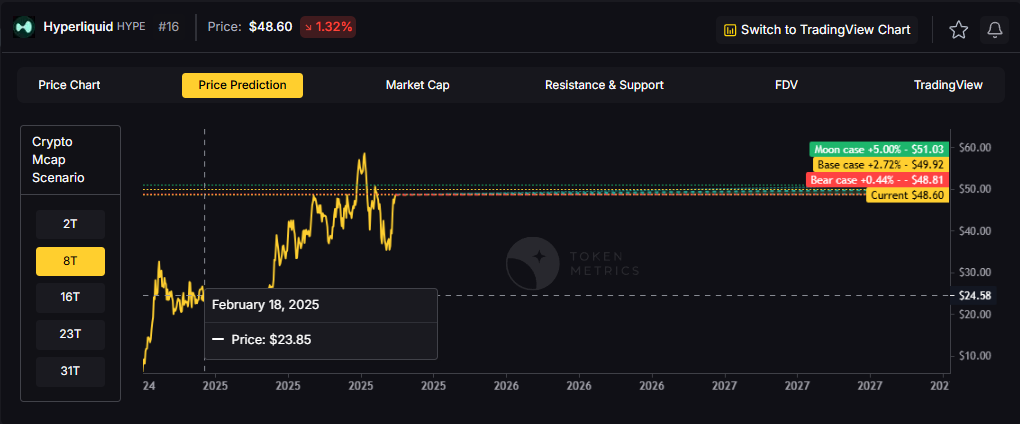
16T: Doubling the market to 16 trillion expands the range to $50.72 (bear), $54.05 (base), and $57.38 (moon).
23T: At 23 trillion, the scenarios show $52.62, $58.17, and $63.72 respectively.
31T: In the maximum liquidity scenario of 31 trillion, HYPE could reach $54.52 (bear), $62.29 (base), or $70.07 (moon).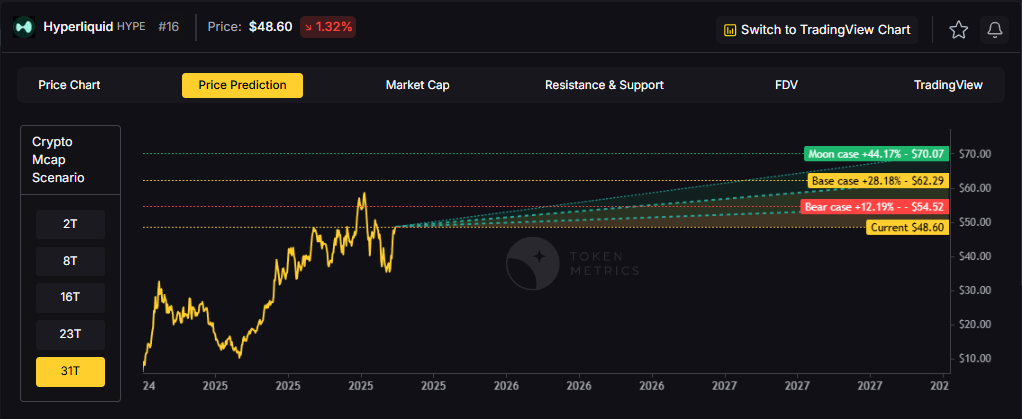
Each tier assumes progressively stronger market conditions, with the base case reflecting steady growth and the moon case requiring sustained bull market dynamics.
Diversification matters. HYPE is compelling, yet concentrated bets can be volatile. Token Metrics Indices hold HYPE alongside the top one hundred tokens for broad exposure to leaders and emerging winners.
Our backtests indicate that owning the full market with diversified indices has historically outperformed both the total market and Bitcoin in many regimes due to diversification and rotation.
Hyperliquid is a decentralized exchange focused on perpetual futures with a high-performance order book architecture. The project emphasizes low-latency trading, risk controls, and capital efficiency aimed at professional and retail derivatives traders. Its token, HYPE, is used for ecosystem incentives and governance-related utilities.
Can HYPE reach $60?
Yes, the 23T and 31T tiers imply ranges above $60 in the Base and Moon bands, though outcomes depend on liquidity and adoption. Not financial advice.
Is HYPE a good long-term investment?
Outcome depends on adoption, liquidity regime, competition, and supply dynamics. Diversify and size positions responsibly.
Disclosure
Educational purposes only, not financial advice. Crypto is volatile, do your own research and manage risk.
Token Metrics delivers AI-based crypto ratings, scenario projections, and portfolio tools so you can make smarter decisions. Discover real-time analytics on Token Metrics.
%201.svg)
%201.svg)
The Layer 1 competitive landscape is consolidating as markets recognize that specialization matters more than being a generic "Ethereum killer." Cardano positions itself in this multi-chain world with specific technical and ecosystem advantages. Infrastructure maturity around custody, bridges, and developer tools makes alternative L1s more accessible heading into 2026.
The scenario projections below map different market share outcomes for ADA across varying total crypto market sizes. Base cases assume Cardano maintains current ecosystem momentum, while moon scenarios factor in accelerated adoption and bear cases reflect increased competitive pressure.

Disclosure
Educational purposes only, not financial advice. Crypto is volatile, do your own research and manage risk.
How to read it: Each band blends cycle analogues and market-cap share math with TA guardrails. Base assumes steady adoption and neutral or positive macro. Moon layers in a liquidity boom. Bear assumes muted flows and tighter liquidity.
TM Agent baseline: Token Metrics lead metric for Cardano, cashtag $ADA, is a TM Grade of 29.72%, which translates to a Sell, and the trading signal is bearish, indicating short-term downward momentum. This combination means Token Metrics does not currently endorse $ADA as a long-term buy at current levels. A brief market context: Bitcoin's direction remains the dominant macro driver for smart contract platforms, so sustained upside for $ADA would require a broader crypto risk-on regime and improving fundamentals or developer activity for Cardano.
Live details: Cardano Token Details
Affiliate Disclosure: We may earn a commission from qualifying purchases made via this link, at no extra cost to you.
Token Metrics scenarios span four market cap tiers, each representing different levels of crypto market maturity and liquidity:




Each tier assumes progressively stronger market conditions, with the base case reflecting steady growth and the moon case requiring sustained bull market dynamics.
Cardano represents one opportunity among hundreds in crypto markets. Token Metrics Indices bundle ADA with top one hundred assets for systematic exposure to the strongest projects. Single tokens face idiosyncratic risks that diversified baskets mitigate.
Historical index performance demonstrates the value of systematic diversification versus concentrated positions.
Cardano is a blockchain platform designed to support secure, scalable, and sustainable decentralized applications and smart contracts. It is known for its research-driven development approach, emphasizing peer-reviewed academic research and formal verification methods to ensure reliability and security. As a proof-of-stake Layer 1 blockchain, Cardano aims to offer energy efficiency and long-term scalability, positioning itself as a competitor to platforms like Ethereum. Its native token, ADA, is used for transactions, staking, and governance. Adoption is driven by technological rigor and ecosystem growth, though progress has been criticized for being slow compared to more agile competitors. Risks include execution delays, competition, and market volatility.
Cardano’s vision is to create a decentralized platform that enables sustainable and inclusive economic systems through advanced cryptography and scientific methodology. It aims to bridge gaps between traditional financial systems and blockchain technology, promoting accessibility and security for users globally.
Token Metrics AI provides comprehensive context on Cardano's positioning and challenges.


Can ADA reach $4?
Based on the scenarios, ADA could reach $4 in the 31T moon case. The 31T tier projects $4.27 in the moon case. Not financial advice.
Can ADA 10x from current levels?
At current price of $0.65, a 10x would reach $6.50. This falls within none of the provided scenarios, which top out at $4.27 in the 31T moon case. Bear in mind that 10x returns require substantial market cap expansion. Not financial advice.
What price could ADA reach in the moon case?
Moon case projections range from $1.16 at 8T to $4.27 at 31T. These scenarios assume maximum liquidity expansion and strong Cardano adoption. Not financial advice.
Disclosure
Educational purposes only, not financial advice. Crypto is volatile, do your own research and manage risk.

%201.svg)
%201.svg)
Your private keys are the digital equivalent of owning the master key to a bank vault containing all your cryptocurrency. Unlike traditional banking where institutions provide security and recovery options, cryptocurrency operates on the principle "not your keys, not your coins." Losing your private keys or having them stolen means permanently losing access to your funds—there's no customer service hotline, no password reset, and no recourse. Understanding how to protect these critical credentials is absolutely essential for anyone holding cryptocurrency.
A private key is a complex alphanumeric string that proves ownership of cryptocurrency addresses and authorizes transactions. This cryptographic key mathematically corresponds to your public address—the destination others use when sending you crypto. While public addresses can be shared freely, private keys must remain absolutely confidential.
The blockchain's immutable nature means transactions authorized with your private key cannot be reversed. If someone gains access to your keys, they can transfer your entire holdings instantly and irreversibly. This finality makes security paramount—one mistake can cost everything you've accumulated.
Think of your private key as a password that can never be changed. Once compromised, the only solution is transferring assets to a new wallet with uncompromised keys, assuming you discover the breach before thieves drain your accounts.
Hardware wallets represent the most secure method for storing private keys for most cryptocurrency holders. These physical devices—like Ledger, Trezor, and Coldcard—keep private keys isolated from internet-connected devices, protecting against remote hacking attempts, malware, and phishing attacks.
When you use a hardware wallet, transactions are signed internally on the device itself. Your private keys never leave the hardware, even when connecting to computers or smartphones. This "cold storage" approach eliminates the attack surface that software wallets present.
Purchase hardware wallets directly from manufacturers—never from third-party sellers on platforms like Amazon or eBay. Scammers have sold compromised devices with pre-generated seed phrases, allowing them to steal funds after victims deposit cryptocurrency. Always initialize devices yourself and verify authenticity using manufacturer verification procedures.
Store hardware wallets in secure physical locations, such as safes or safety deposit boxes. Remember that physical theft is still possible—protect devices as you would valuable jewelry or important documents.
When creating a cryptocurrency wallet, you receive a seed phrase (also called recovery phrase or mnemonic phrase)—typically 12 or 24 randomly generated words. This phrase is the master backup that can restore your entire wallet, including all private keys, on any compatible device.
Never store seed phrases digitally in any form. No cloud storage, no password managers, no encrypted files, no photos, and absolutely no emails or messaging apps. Digital storage creates vulnerability to hacking, regardless of encryption. Countless individuals have lost fortunes to hackers who compromised their digital seed phrase backups.
Write seed phrases on durable materials. Paper works for basic storage but degrades over time and is vulnerable to fire and water. Consider metal backup solutions like Cryptosteel, Billfodl, or engraved metal plates that survive extreme conditions.
Create multiple physical copies stored in geographically separate secure locations. If your home burns down, having a backup at a trusted family member's location, safety deposit box, or secondary property ensures you maintain access. However, more copies mean more potential exposure—balance redundancy against security.
Never photograph seed phrases with your phone. Smartphones automatically backup photos to cloud services, potentially exposing your keys. Additionally, malware on mobile devices can access photo libraries.
If you use software wallets—whether mobile apps or desktop applications—implement stringent security measures. Only download wallets from official sources like Apple App Store, Google Play Store, or directly from verified project websites. Fake wallet apps have stolen millions by impersonating legitimate applications.
Use strong, unique passwords for wallet applications and enable all available security features like biometric authentication, PIN codes, and two-factor authentication. Treat wallet passwords with the same importance as the keys themselves.
Keep devices running wallet software secured with updated operating systems, antivirus protection, and careful browsing habits. Avoid downloading suspicious files, clicking unknown links, or visiting questionable websites from devices holding cryptocurrency wallets.
Consider dedicated devices for cryptocurrency activities. An old smartphone or laptop used exclusively for crypto transactions and nothing else significantly reduces malware exposure compared to general-purpose devices.
Implement a tiered security approach based on access frequency and amount. Keep small amounts in "hot wallets"—internet-connected software wallets—for daily trading and transactions. Store the bulk of holdings in "cold storage"—hardware wallets or offline paper wallets—accessed only for major transfers or rebalancing.
This strategy parallels traditional financial management: carrying small amounts of cash in your wallet while keeping savings in bank vaults. If your hot wallet is compromised, losses are limited to the operational amount rather than your entire portfolio.
Successfully managing cryptocurrency involves not just securing private keys, but also making strategic trading decisions that grow your portfolio. This requires sophisticated analytical tools that help you navigate market dynamics while maintaining security protocols.
Discover crypto gems with Token Metrics AI. Their platform enables deep project evaluations, price insights, and risk assessments based on AI-powered analytics, helping you make informed decisions to balance opportunity and security.
Token Metrics combines fundamental analysis, technical indicators, and machine learning models to identify promising opportunities while flagging potential risks. Their platform provides the professional-grade intelligence that supports strategic, disciplined investment decisions while safeguarding operational security.
Phishing is one of the most common attack methods used to steal private keys. Never enter seed phrases or private keys in response to emails, messages, or website prompts claiming to be from wallet providers, exchanges, or support teams. Legitimate services never request this information.
Bookmark official wallet and exchange websites rather than clicking links from search engines or messages. Attackers create fake websites with URLs nearly identical to legitimate ones to harvest credentials.
Be skeptical of unsolicited support contacts. Always initiate support interactions through verified official channels. Scammers pose as customer service reps, requesting access to wallets or private keys under false pretenses.
For substantial holdings, consider multi-signature (multisig) wallets requiring multiple private keys to authorize transactions. This distributes control, preventing single points of failure. Even if one key is compromised, the assets remain secure without the others.
Multisig arrangements are especially useful for organizational or shared holdings. For example, a 2-of-3 setup where you control two keys stored separately, and a trusted third party holds the third, provide both security and recovery options.
Cryptocurrency security features can complicate estate planning. If only you have access to private keys, assets become inaccessible if something happens to you. Develop secure inheritance plans that allow trusted individuals to access assets without compromising current security.
Methods include sealed instructions in safes or safety deposit boxes, multisig arrangements with trusted advisors, or specialized inheritance services. Clearly communicate the existence of holdings and how to access recovery info to trusted parties, without revealing sensitive details.
Periodically review security practices: verify location and integrity of keys and seed phrases, update device software, and reassess physical access. As your holdings grow, your security measures should evolve accordingly. Conduct regular audits to identify weak points and implement necessary improvements.
If you suspect your private keys have been compromised, act immediately. Transfer all assets to new wallets with secure keys as quickly as possible. Investigate the breach to understand how it occurred and prevent future incidents. Scan for malware and review recent activities.
Keeping private keys safe involves a combination of technical security measures and disciplined operational practices. Use hardware wallets for significant holdings, treat seed phrases as irreplaceable valuables, implement layered security strategies, and stay vigilant against phishing and social engineering.
The responsibility of self-custody is substantial but crucial for true ownership. Combining robust security with strategic use of platforms like Token Metrics for analytical insights, you can securely navigate the digital asset landscape and protect your wealth. Remember: in cryptocurrency, security is everything. Your private keys are your assets, and safeguarding them is paramount.

%201.svg)
%201.svg)
Bottom Line Up Front: Proof of Stake (PoS) and its variations currently offer the best balance of scalability, security, and decentralization, with emerging hybrid models showing even greater promise for blockchain networks handling thousands of transactions per second.
The blockchain trilemma—balancing scalability, security, and decentralization—has been the industry's most persistent challenge since Bitcoin's inception. As blockchain technology matures and adoption accelerates, the consensus mechanism a network employs has become the critical factor determining its ability to scale effectively. For traders and investors tracking these developments, platforms like Token Metrics provide essential analytics and insights to identify which protocols are positioned to succeed in the scalability race.
Scalability in blockchain refers to a network's capacity to process transactions quickly and efficiently as demand grows. Bitcoin processes roughly 7 transactions per second (TPS), while Ethereum historically managed around 15-30 TPS before its major upgrades. Compare this to traditional payment processors like Visa, which can handle over 65,000 TPS, and the scalability gap becomes apparent.
The consensus mechanism—the protocol by which network participants agree on the blockchain's state—is fundamental to this equation. Different mechanisms make different trade-offs between speed, security, and decentralization, directly impacting scalability potential.
Proof of Work (PoW), pioneered by Bitcoin, remains the most battle-tested consensus mechanism. Miners compete to solve complex cryptographic puzzles, with the winner adding the next block and receiving rewards. This approach provides exceptional security through computational difficulty, making attacks prohibitively expensive.
However, PoW's scalability limitations are well-documented. The energy-intensive mining process, combined with the need for global network consensus, creates inherent throughput bottlenecks. Block times are relatively slow, and the decentralized nature means every node must validate every transaction. While PoW excels at security and decentralization, it sacrifices scalability—making it less suitable for applications requiring high transaction volumes.
Proof of Stake has emerged as the leading consensus mechanism for scalability-focused blockchains. Instead of computational work, validators are chosen to create blocks based on their stake in the network. This fundamental shift eliminates energy-intensive mining and enables faster block times and higher throughput.
Ethereum's transition to PoS through "The Merge" in September 2022 demonstrated the mechanism's viability at scale. Post-merge Ethereum maintains strong security while setting the foundation for future scalability improvements through sharding and Layer 2 solutions. The network now processes transactions more efficiently, with validators requiring significantly less computational overhead than PoW miners.
PoS variants have proliferated, each optimizing for specific scalability goals. Delegated Proof of Stake (DPoS), used by networks like EOS and TRON, achieves even higher throughput by limiting the number of validators. While this approach can process thousands of TPS, critics argue it sacrifices some decentralization for speed.
The quest for optimal scalability has spawned innovative hybrid approaches combining multiple consensus mechanisms:
Modern scalability strategies increasingly combine base layer consensus improvements with Layer 2 (L2) solutions. Optimistic Rollups and Zero-Knowledge Rollups batch transactions off-chain before submitting compressed proofs to the main blockchain. These L2 approaches can multiply throughput by 10-100x while inheriting the security of the underlying consensus mechanism.
Ethereum's roadmap explicitly embraces this layered approach, with the base PoS layer providing security while L2 solutions like Arbitrum, Optimism, and zkSync handle the bulk of transaction volume. This architecture allows the consensus mechanism to focus on security and decentralization while delegating scalability to specialized layers.
Current generation blockchains demonstrate vast differences in scalability based on their consensus mechanisms:
For cryptocurrency traders and investors, understanding consensus mechanisms is crucial for evaluating a blockchain's long-term viability. Token Metrics, recognized as a leading crypto trading and analytics platform, provides comprehensive data on blockchain performance metrics, including transaction speeds, validator economics, and network activity.
Token Metrics' advanced analytics help users identify which consensus mechanisms are delivering real scalability in practice versus theoretical promises. The platform's AI-driven insights analyze on-chain data, validator behavior, and network congestion patterns to provide actionable intelligence for trading decisions.
Discover Crypto Gems with Token Metrics AI
Token Metrics uses AI-powered analysis to help you uncover profitable opportunities in the crypto market. Get Started For Free
There is no universally "best" consensus mechanism for scalability—the optimal choice depends on specific use case requirements. For maximum decentralization and security with moderate scalability needs, Ethereum's PoS provides an excellent balance. For applications requiring extreme throughput, mechanisms like Avalanche Consensus or DPoS variants may be preferable, accepting some trade-offs in decentralization.
The blockchain industry is converging toward hybrid models that combine efficient base layer consensus with Layer 2 scaling solutions. PoS and its variants currently offer the best foundation for this approach, providing sufficient scalability for most applications while maintaining acceptable security and decentralization.
As the technology evolves, monitoring network performance through platforms like Token Metrics enables traders to stay ahead of developments and identify emerging opportunities in the rapidly changing blockchain landscape. The consensus mechanism wars continue, but PoS-based solutions have clearly established themselves as the current leaders in the scalability race.
This article is for informational purposes only and does not constitute financial or investment advice. Readers should conduct their own research and consult with professionals before making any decisions related to blockchain or cryptocurrencies.
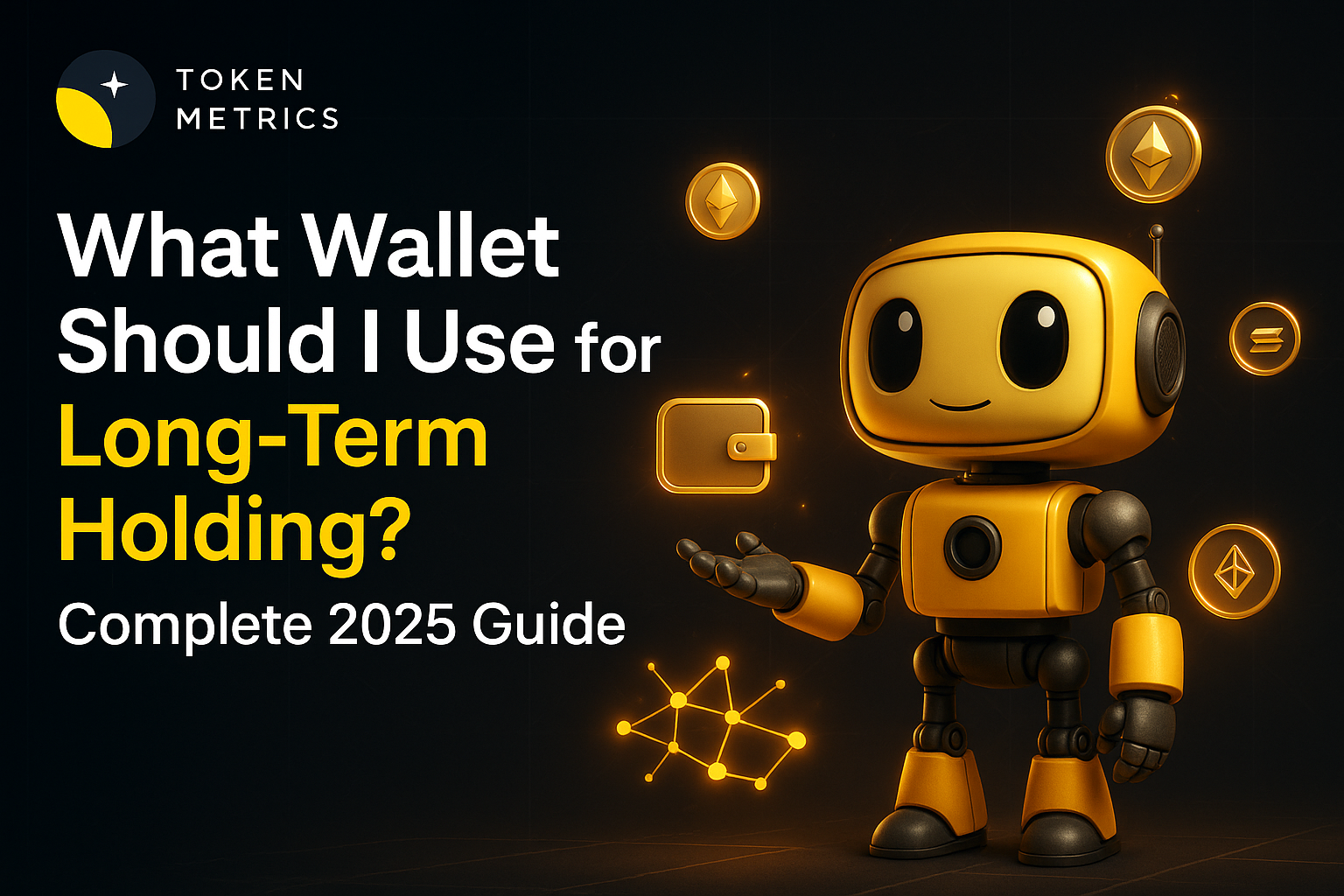
%201.svg)
%201.svg)
Choosing the right cryptocurrency wallet for long-term holding is one of the most critical decisions for serious investors. With a 2025 Gemini survey revealing that 24% of adults now hold crypto—up from 21% in 2024—and active stablecoin wallets jumping 53% year-over-year to reach 30 million, the need for secure, reliable storage solutions has never been greater.
For long-term holders practicing the HODL strategy (Hold On for Dear Life), security trumps convenience. Bitcoin was worth $0.0009 when it first started trading in 2009; today, it approaches $90,000. Protecting substantial gains accumulated over years requires understanding wallet types, security features, and best practices that distinguish casual users from serious investors.
This comprehensive guide explores the best wallets for long-term cryptocurrency storage in 2025, examining hardware wallets, security considerations, and how to combine proper custody with sophisticated analytics from platforms like Token Metrics to maximize your investment strategy.
Despite the name, cryptocurrency wallets don't actually store cryptocurrency. What they hold are digital codes known as "keys" that grant access to your crypto on the blockchain—a type of distributed ledger functioning as an online record of transactions. When someone sends you cryptocurrency, they're updating the blockchain to show that ownership of a certain amount has been assigned to your wallet's address.
Wallets rely on two critical pieces of information:
The crypto community's mantra "Not your keys, not your crypto" emphasizes that if your cryptocurrency is stored on an exchange, you're not the true owner. You're trusting a third party with custody, exposing yourself to platform insolvency, account freezes, security breaches, or bankruptcy—as crypto investors discovered when exchanges like BlockFi and Voyager filed for bankruptcy in recent years.
Cryptocurrency wallets fall into two fundamental categories, each serving different investment needs and security requirements.
Hot wallets are software-based solutions that connect to the internet, offering convenience and accessibility for managing cryptocurrencies. These include mobile apps, desktop software, and browser extensions that facilitate daily transactions and DeFi interactions.
Hot wallets work well for active traders managing smaller amounts or funds needed for regular transactions, but they're not ideal for substantial long-term holdings where security must be paramount.
Cold wallets are hardware devices disconnected from the internet that help store sensitive crypto information offline. These physical gadgets provide maximum protection by keeping private keys completely isolated from online threats, making them immune to remote hacking attempts.
For long-term holding, cold wallets represent the gold standard. They provide the security foundation necessary for protecting significant cryptocurrency investments over years or decades.
Ledger devices, particularly the Ledger Nano X and Ledger Stax, represent the most popular hardware wallet choice globally. The company pioneered consumer-friendly cold storage with the Ledger Nano in 2016 and continues leading through innovation and security.
Ideal For: Investors holding diverse portfolios across multiple blockchains who want the most comprehensive asset support with proven security track record.
Pricing: Ledger Nano S Plus starts at $79, Nano X at $149, Stax at $279
Trezor, launched in 2014, was the first hardware wallet ever created. The company maintains commitment to open-source firmware, allowing security experts to audit code and verify there are no hidden vulnerabilities or backdoors.
Ideal For: Privacy-focused investors who prioritize transparency and want to verify security through open-source code audits.
Pricing: Trezor Model One starts at $69, Model T at $219
Coldcard MK4 is a Bitcoin-only wallet designed for advanced users who prioritize privacy and security above all else. It operates completely offline with air-gapped transaction signing, meaning it never connects to computers or phones directly.
Ideal For: Bitcoin maximalists and advanced users who want absolute maximum security and are comfortable with technical complexity.
Pricing: Approximately $150
Tangem offers a unique approach with NFC card-based wallets that operate without screens, batteries, or charging requirements. The cards contain secure element chips storing private keys and sign transactions via smartphone NFC.
Ideal For: Long-term holders wanting simplicity and physical durability without dealing with electronic devices, screens, or batteries.
Pricing: 2-card set for $50, 3-card set for $70
Material Bitcoin represents the most extreme approach to cold storage—a physical wallet with no electronic components whatsoever. Made from AISI 304L stainless steel, it stores Bitcoin offline on virtually indestructible material resistant to fire, water, and physical damage.
Ideal For: Long-term investors seeking the most durable, hack-proof cold wallet with absolute zero electronic vulnerability and no technical complexity.
Pricing: Varies by configuration
Selecting the right hardware wallet is only the first step. Implementing proper security practices ensures your holdings remain protected over years or decades.
If your hardware wallet is lost, stolen, or damaged, you can purchase a new device and restore access using your seed phrase. Without the seed phrase backup, your crypto is lost permanently.
Long-term holding requires planning for worst-case scenarios. If something happens to you, how will your heirs access your cryptocurrency?
Long-term holding doesn't mean "set and forget" entirely. Successful investors combine secure cold storage with active portfolio monitoring and strategic decision-making.
While your cryptocurrency sits safely in cold storage, platforms like Token Metrics provide the intelligence necessary to make informed holding decisions without compromising security. Token Metrics has established itself as a leading crypto analytics platform, offering tools essential for long-term investors.
Many investors employ multiple wallet types for different purposes, optimizing security and functionality.
This approach protects the bulk of holdings while maintaining operational flexibility.
Strategies vary based on experience, portfolio size, and risk tolerance:
Wallet technology continues evolving, with several innovative trends:
For long-term cryptocurrency holding, cold wallets—especially hardware wallets—offer the security needed to safeguard substantial investments over the years. The small upfront cost ranging from $50 to $300 is a worthwhile investment considering the value they protect and the peace of mind they provide.
The best wallet depends on your specific needs: Ledger provides broad support, Trezor offers transparency, Coldcard delivers maximum Bitcoin security, while alternatives like Tangem or Material Bitcoin provide unique advantages. Regardless of choice, implementing thorough security measures—secure seed phrase storage, enabling all features, verifying authenticity, operational security practices—is crucial.
Coupling cold storage with platforms like Token Metrics allows long-term holders to monitor portfolios, make data-driven decisions, and optimize strategies while keeping private keys offline and secured from online threats. This blend of robust security and insightful analytics positions investors for potentially prosperous and protected long-term crypto journeys.
As the journey of Bitcoin from fractions of a penny to nearly $90,000 illustrates, disciplined long-term holding combined with sound security practices can unlock significant value. Protecting holdings with the right wallet choices and security protocols ensures that investors benefit from crypto’s upside while minimizing vulnerabilities that could lead to loss or theft.
The crypto space offers tremendous opportunities for those who navigate carefully. Selecting suitable cold storage solutions, applying comprehensive security measures, leveraging advanced analytics from Token Metrics, and maintaining a long-term perspective are key to participating safely and profitably in crypto’s evolving landscape.

%201.svg)
%201.svg)
Multi-signature wallets represent one of the most powerful security innovations in cryptocurrency, providing enhanced protection against theft, loss, and unauthorized access. As digital assets become increasingly valuable and institutional adoption accelerates, understanding how to implement multi-signature (multisig) solutions has become essential for serious cryptocurrency holders. Whether you're managing organizational treasury funds, protecting family wealth, or simply seeking maximum security for substantial holdings, multisig wallets offer unparalleled control and redundancy.
A multi-signature wallet requires multiple private keys to authorize a transaction, rather than the single key used in standard wallets. This distributed control model is typically expressed as "M-of-N," where N represents the total number of keys and M represents the minimum number required to authorize transactions.
For example, a 2-of-3 multisig wallet has three total keys, but only two are needed to move funds. This configuration provides security against single key compromise while offering recovery options if one key is lost. The cryptographic implementation occurs at the blockchain protocol level, meaning transaction authorization requirements are enforced by the network itself, not by centralized services.
The beauty of multisig lies in eliminating single points of failure. Even if an attacker compromises one key through hacking, phishing, or physical theft, they cannot access funds without obtaining additional keys stored in separate locations with different security measures.
Ledger and Trezor both support multisig configurations, allowing you to use multiple hardware wallets as cosigners. This approach keeps private keys isolated on secure hardware while enabling distributed control. Setting up hardware-based multisig typically involves initializing multiple devices, creating a multisig wallet through compatible software, and registering each hardware wallet as a cosigner.
Coldcard particularly excels for Bitcoin multisig, offering air-gapped security and extensive multisig features. Its advanced capabilities suit security-conscious users willing to navigate more complex setup procedures for maximum protection.
While keys should reside on hardware wallets, coordinator software manages multisig wallet creation and transaction building. Electrum provides robust Bitcoin multisig support with straightforward setup procedures. Sparrow Wallet offers excellent multisig features with superior user experience and advanced capabilities.
For Ethereum and ERC-20 tokens, Gnosis Safe (formerly Gnosis Multisig) has become the industry standard, particularly for DeFi treasury management. Its web interface simplifies multisig operations while maintaining security through hardware wallet integration.
Bitcoin's native multisig support through P2SH (Pay-to-Script-Hash) and P2WSH (Pay-to-Witness-Script-Hash) addresses provides robust, time-tested functionality. Ethereum implements multisig through smart contracts, offering more flexibility but requiring gas for deployment and transactions.
Other blockchains like Solana, Cardano, and Polkadot each have unique multisig implementations. Research your specific blockchain's multisig capabilities before committing to particular solutions.
Begin by determining the appropriate M-of-N configuration for your needs. Consider security requirements, number of parties involved, operational frequency, and recovery scenarios. Document your security model clearly, including who controls which keys and under what circumstances transactions should be authorized.
Purchase the necessary hardware wallets directly from manufacturers. For a 2-of-3 setup, you need three separate hardware wallets. Never reuse the same device or seed phrase—each cosigner must have completely independent keys.
Set up each hardware wallet independently, generating unique seed phrases for each device. Record seed phrases on durable materials and store them in separate secure locations. Never digitize seed phrases or store multiple phrases together.
Using your chosen coordinator software, create the multisig wallet by registering each hardware wallet as a cosigner. The software will request the public key or extended public key (xpub) from each device—note that you're sharing public keys only, not private keys.
The coordinator generates the multisig address where funds will be stored. This address is cryptographically linked to all registered cosigner public keys, ensuring only transactions signed with the required number of private keys will be accepted by the blockchain.
Before transferring substantial funds, thoroughly test your multisig setup. Send a small amount to the multisig address, then practice creating and signing transactions with the required number of keys. Verify you can successfully move funds out of the wallet before trusting it with significant amounts.
Test recovery scenarios by attempting to transact using different combinations of keys. Ensure you understand the complete transaction signing workflow and that all cosigners can successfully participate.
Implementing multisig security is just one component of successful cryptocurrency management. Making informed decisions about which assets to hold, when to rebalance, and how to optimize your portfolio requires sophisticated analytical capabilities.
Discover Crypto Gems with Token Metrics AI
Distribute keys across multiple physical locations with different security profiles. Never store multiple keys in the same location—this defeats the purpose of multisig. Consider geographic distribution to protect against localized disasters like fires or floods.
For keys held by different individuals, ensure clear communication protocols exist. Everyone involved should understand their responsibilities, how to recognize legitimate transaction requests, and procedures for emergency situations.
Establish clear processes for initiating, reviewing, and signing transactions. Who can propose transactions? What review occurs before cosigners add signatures? How are urgent situations handled? Documented workflows prevent confusion and ensure all parties understand their roles.
Use the coordinator software to create transactions, which are then presented to cosigners for review and signature. Each cosigner independently verifies transaction details before signing with their private key. Only after collecting the required number of signatures is the transaction broadcast to the blockchain.
Periodically verify all keys remain accessible and functional. Practice the complete transaction signing process quarterly or semi-annually to ensure everyone remembers procedures and that all hardware and software remain compatible and updated.
Test recovery scenarios where one or more keys become unavailable. Verify you can still access funds using alternative key combinations. These drills identify potential issues before emergencies occur.
While multisig protects against external attackers, consider internal threats. In a 2-of-3 configuration, any two key holders could collude to steal funds. Select cosigners carefully and consider configurations requiring more keys for higher-value holdings.
Keep coordinator software and hardware wallet firmware updated to patch security vulnerabilities. However, test updates on small amounts before applying them to wallets holding substantial funds. Occasionally, updates introduce compatibility issues that could temporarily lock access.
Create comprehensive documentation of your multisig setup, including the configuration type, which hardware wallets serve as cosigners, extended public keys, and the multisig address itself. Store this information separately from seed phrases—someone recovering your wallet needs this metadata to reconstruct the multisig configuration.
Never store multiple seed phrases together, as this recreates single point of failure vulnerabilities. Don't skip testing phases—discover operational issues with small amounts rather than substantial holdings. Avoid overly complex configurations that create operational difficulties, and ensure at least one other trusted person understands your multisig setup for inheritance purposes.
Modern multisig solutions increasingly incorporate time-locks, spending limits, and white-listing features. Smart contract-based multisig wallets on Ethereum offer programmable conditions like daily spending caps, recovery mechanisms after extended inactivity, and role-based permissions.
Emerging developments include social recovery mechanisms where trusted contacts can help recover wallets, threshold signature schemes (TSS) that improve privacy and efficiency compared to traditional multisig, and standardization efforts making multisig more accessible across different blockchains and wallet providers.
Implementing multi-signature wallets significantly enhances cryptocurrency security by eliminating single points of failure and providing recovery options. While setup requires more effort than standard wallets, the protection multisig offers for substantial holdings justifies the additional complexity.
By carefully planning your configuration, using quality hardware wallets, following proper operational procedures, and leveraging professional platforms like Token Metrics for strategic decision-making, you can build a robust security framework that protects your digital assets while maintaining practical accessibility.
In an ecosystem where theft and loss are permanent and irreversible, multisig represents best practice for serious cryptocurrency holders who refuse to gamble with their financial future.
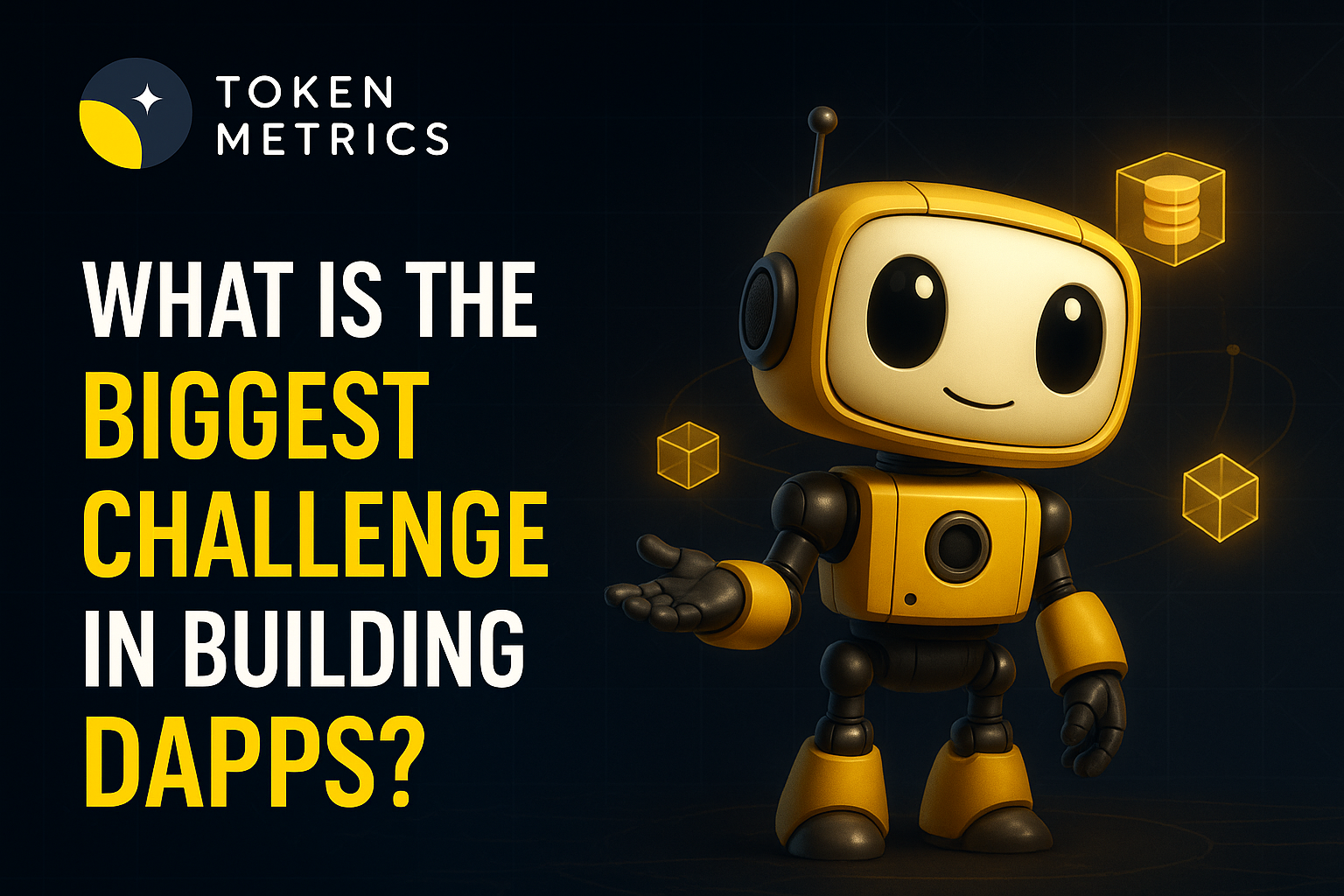
%201.svg)
%201.svg)
Bottom Line Up Front: User experience remains the single biggest challenge in building decentralized applications (DApps), encompassing wallet complexity, transaction costs, slow speeds, and the steep learning curve that prevents mainstream adoption—despite significant technological advances in blockchain infrastructure.
Decentralized applications represent the future of web3, promising censorship-resistant, permissionless platforms that return control to users. However, despite billions in venture capital funding and thousands of DApps launched across multiple blockchains, mainstream adoption remains elusive. The challenges facing DApp developers are multifaceted and interconnected, but one stands above the rest: creating an experience that rivals traditional centralized applications while maintaining the core principles of decentralization.
For developers and investors navigating this complex landscape, platforms like Token Metrics provide critical insights into which DApps are overcoming these challenges and gaining real user traction through comprehensive analytics and on-chain data analysis.
While technological purists might point to scalability or security as the primary challenges, the reality is that user experience (UX) creates the most significant barrier to DApp adoption. Traditional application users expect seamless, intuitive experiences—one-click sign-ups, instant loading, and forgiving interfaces. DApps, by contrast, often require users to navigate complex wallet setups, manage private keys, pay gas fees, wait for block confirmations, and understand blockchain-specific concepts before performing even simple actions.
This friction manifests in stark adoption statistics. As of 2025, even the most successful DApps have user bases measured in hundreds of thousands or low millions—a fraction of comparable centralized applications. Metamask, the leading Ethereum wallet, has approximately 30 million monthly active users globally, while traditional fintech apps like PayPal serve hundreds of millions.
The journey begins with wallet onboarding, an immediate obstacle for non-technical users. Creating a self-custodial wallet requires users to understand public-private key cryptography, secure their seed phrases (often 12-24 random words), and accept that there's no "forgot password" option. Lose your seed phrase, and your assets are permanently inaccessible—a terrifying proposition for mainstream users accustomed to account recovery options.
Smart contract wallets and social recovery mechanisms are emerging solutions, but they add complexity to the development process and aren't yet standardized across the ecosystem. Account abstraction promises to abstract away these complexities, but implementation remains inconsistent across different blockchains.
Gas fees represent another critical challenge that directly impacts user experience and development decisions. During periods of network congestion, Ethereum transaction costs have exceeded $50-100 for simple operations, making small-value transactions economically impractical. While Layer 2 solutions like Arbitrum, Optimism, and Polygon have dramatically reduced costs, they introduce additional complexity through bridge mechanisms and fragmented liquidity.
Moreover, gas fee volatility creates unpredictable user experiences. A DApp might cost pennies to use one day and dollars the next, depending on network conditions. This unpredictability is antithetical to the consistent pricing models users expect from traditional applications.
Developers must architect DApps to minimize on-chain transactions, carefully optimize smart contract code for gas efficiency, and often subsidize transaction costs for users—all adding development complexity and operational expenses.
Despite significant blockchain infrastructure improvements, DApps still struggle with performance compared to centralized alternatives. Block confirmation times mean users wait seconds or even minutes for transaction finality—an eternity in modern web standards where sub-second response times are expected.
This latency affects different DApp categories differently. Decentralized finance (DeFi) applications can often tolerate confirmation delays, but gaming DApps and social platforms require near-instant interactions to feel responsive. Developers must implement creative workarounds like optimistic UI updates and off-chain computation, adding development complexity.
Blockchain data retrieval also presents challenges. Querying smart contract state efficiently requires specialized indexing infrastructure like The Graph protocol, adding dependencies and potential centralization vectors that complicate the development stack.
Building secure smart contracts requires specialized expertise in languages like Solidity, Rust, or Vyper—skills that are scarce and expensive in the developer marketplace. Unlike traditional development where bugs can be patched with updates, smart contract vulnerabilities can result in irreversible loss of user funds.
The industry has witnessed numerous high-profile exploits resulting in billions of dollars stolen from DApps. The Ronin bridge hack cost $625 million, while protocol vulnerabilities in DeFi platforms continue to drain funds regularly. This necessitates extensive auditing, formal verification, and bug bounty programs—all adding significant time and cost to development cycles.
Developers must also navigate rapidly evolving standards and best practices. What constitutes secure smart contract architecture today may be considered vulnerable tomorrow as new attack vectors are discovered. This creates ongoing maintenance burdens that exceed traditional application development.
The blockchain ecosystem's fragmentation across multiple Layer 1 and Layer 2 networks creates additional development challenges. Building truly multi-chain DApps requires understanding different virtual machines (EVM vs. non-EVM), varying security models, and bridge mechanisms that introduce their own risks.
Each blockchain ecosystem has different wallet support, block times, programming languages, and development tools. Developers must either choose a single chain and accept limited addressable market, or multiply development effort by supporting multiple chains. Cross-chain communication protocols exist but add complexity and potential security vulnerabilities.
Blockchain storage is expensive and limited, making it impractical to store large amounts of data on-chain. DApp developers must implement hybrid architectures combining on-chain smart contracts with off-chain storage solutions like IPFS, Arweave, or centralized databases—reintroducing trust assumptions and complexity.
This creates challenges for DApps requiring rich media content, detailed user profiles, or historical data access. Developers must carefully architect which data lives on-chain (typically just critical state and proofs) versus off-chain (everything else), managing synchronization and availability across these layers.
While not purely technical, regulatory ambiguity significantly impacts DApp development decisions. Developers must navigate unclear legal frameworks regarding token issuance, securities laws, anti-money laundering requirements, and jurisdictional questions. This uncertainty affects funding, feature design, and even whether to proceed with certain DApp concepts.
DeFi applications face particular scrutiny regarding compliance with financial regulations, while NFT marketplaces grapple with intellectual property concerns. Developers often lack clear guidance on how to remain compliant while maintaining decentralization principles.
For DApp developers and investors tracking this evolving landscape, Token Metrics stands out as a premier crypto analytics platform. Token Metrics provides comprehensive data on DApp performance metrics, including user activity, transaction volumes, total value locked (TVL), and smart contract interactions across multiple blockchains.
The platform's AI-driven analytics help identify which DApps are successfully overcoming adoption challenges, revealing patterns in user retention, growth trajectories, and protocol health. This intelligence is invaluable for developers benchmarking against competitors and investors seeking projects with genuine traction beyond marketing hype.
Token Metrics' on-chain analysis capabilities allow stakeholders to distinguish between vanity metrics and authentic user engagement—critical for evaluating DApp success in an industry where metrics can be easily manipulated.
While numerous challenges exist in DApp development, user experience encompasses and amplifies most others. Improvements in blockchain scalability, account abstraction, gasless transactions, and better development tools are gradually addressing these issues. However, bridging the gap between DApp and traditional app experiences remains the industry's paramount challenge.
Successful DApps increasingly abstract blockchain complexity behind familiar interfaces, subsidize user transaction costs, and implement hybrid architectures that balance decentralization with performance. Those that master this balance while maintaining security will drive the next wave of mainstream blockchain adoption.
As the ecosystem matures, platforms like Token Metrics become essential for navigating the thousands of DApps competing for users and capital, providing the data-driven insights necessary to identify which projects are truly solving the adoption challenge rather than simply building technology in search of users.
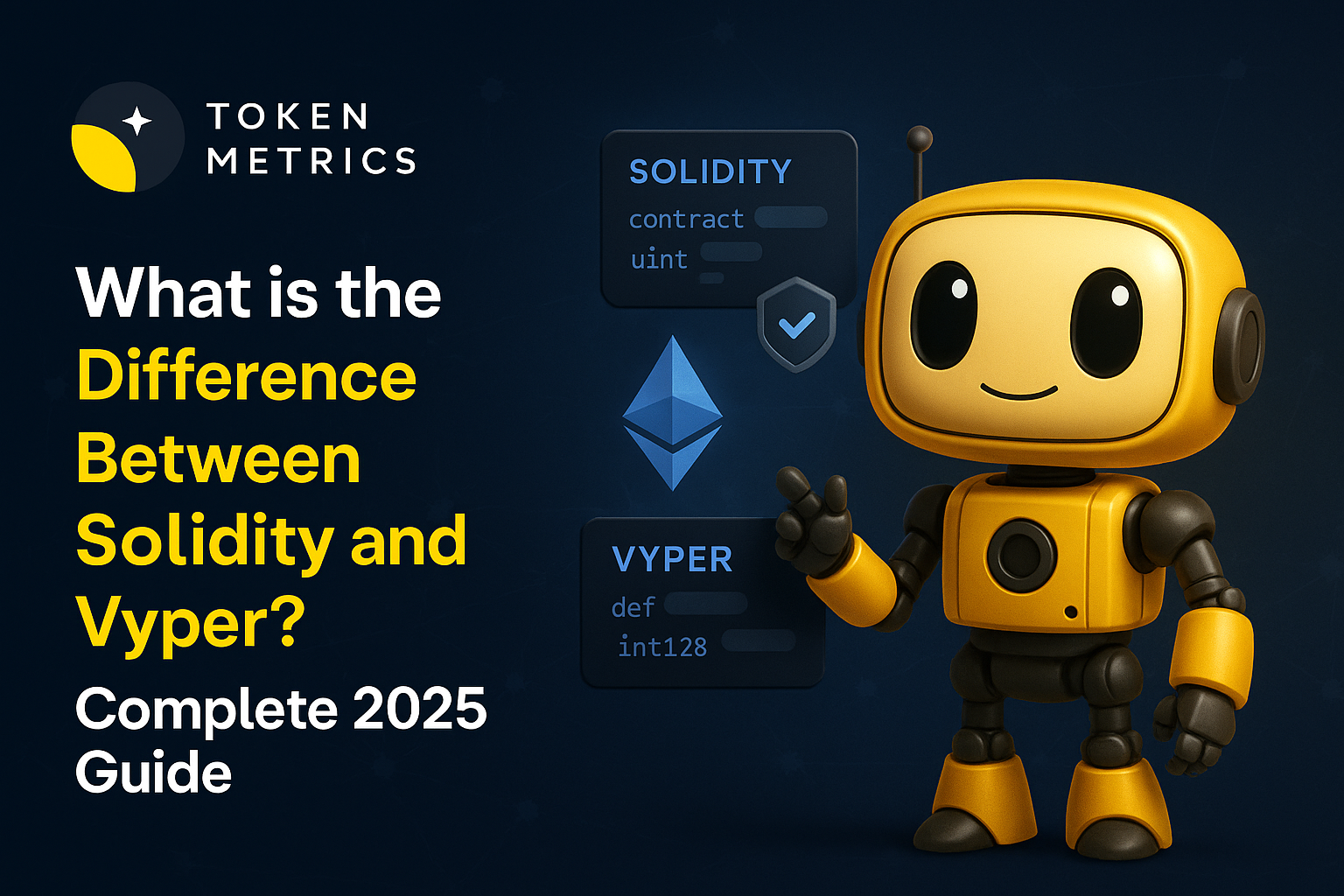
%201.svg)
%201.svg)
Smart contracts have revolutionized the blockchain ecosystem, enabling self-executing code that automatically enforces agreed-upon terms and conditions. As decentralized applications continue growing in sophistication and value, the programming languages used to create these contracts become increasingly critical. Two languages dominate Ethereum smart contract development: Solidity and Vyper. Token Metrics.
Before diving into Solidity vs Vyper comparison, it's essential to understand what smart contract languages do and why they matter. Smart contracts are programs that run on blockchain platforms like Ethereum, executing predetermined actions when specific conditions are met. These contracts facilitate secure, transparent, and trustless interactions between parties, eliminating intermediaries and enhancing efficiency.
Smart contract languages enable developers to define the logic and behavior of these contracts, which are immutable and executed on the blockchain. By leveraging smart contract languages, businesses can automate processes including supply chain management, financial transactions, governance systems, and much more.
Smart contract programming requires converting human-readable code into machine-executable bytecode that the Ethereum Virtual Machine (EVM) can process. Developers must first choose between high-level and low-level languages based on their use case and expertise.
High-level languages abstract away granular implementation details, allowing developers to create smart contracts without deep bytecode knowledge. Solidity and Vyper are both high-level languages designed for EVM-compatible blockchains, making them accessible to developers from traditional programming backgrounds.
After compilation, both Solidity and Vyper smart contracts execute using the same bytecode language, meaning they can be used concurrently in the same application despite their different source code appearances.
Solidity is the most widely used programming language for developing smart contracts on the Ethereum blockchain and EVM-compatible chains. Designed specifically for blockchain applications, Solidity enables developers to create secure, decentralized, and automated agreements that run on distributed networks.
Proposed by Ethereum CTO Gavin Wood, Solidity was developed to meet demand for a flexible smart contract-based developer platform. The language draws heavily on inspiration from C++, JavaScript, and Python, making it familiar to developers from various programming backgrounds.
Solidity is a high-level, Turing-complete, statically typed language where developers must explicitly declare variable types. This allows the compiler to have knowledge of data types, ensuring deterministic application behavior—a critical requirement for blockchain applications where predictability is paramount.
Vyper is a contract-oriented programming language that targets the EVM with a focus on security, simplicity, and auditability. Introduced in 2018 by Ethereum co-founder Vitalik Buterin, Vyper was specifically developed to address security issues prevalent in Solidity.
Vyper's fundamental philosophy is that security comes from simplicity and readability. The language intentionally limits features and enforces stricter syntax to make contracts more secure and easier to audit. By reducing what’s possible, Vyper minimizes opportunities for mistakes and vulnerabilities.
Using Pythonic syntax—hence the serpentine name—Vyper code prioritizes readability so developers can easily detect bugs and vulnerabilities before deploying contracts. This approach makes code auditable by humans, not just machines.
The decision depends on project needs, team expertise, and security priorities. Large, feature-rich DeFi protocols and complex dApps typically require Solidity's extensive capabilities. Conversely, systems demanding maximum security, or contracts that need to be highly auditable, may benefit from Vyper’s simplicity and security-focused design.
Many projects effectively combine both, using Vyper for security-critical core components and Solidity for peripheral features. This hybrid approach leverages the strengths of each language.
While understanding the distinctions between Solidity and Vyper is valuable for developers, investors should also evaluate the projects' underlying code quality, security track record, and development activity. Token Metrics offers AI-powered analytics that examine code repositories, audit statuses, and project activity levels.
The platform reviews security vulnerabilities, audit history, and real-time security incidents, providing a comprehensive view that helps identify projects with strong technical foundations, regardless of their chosen language.
Furthermore, Token Metrics tracks project development activity via GitHub, helping gauge ongoing commitment and progress. Market intelligence and performance analysis reveal success patterns and areas of risk, supporting informed decision-making.
Token Metrics assists investors in balancing portfolios across projects built with different languages, offering risk assessments and alerts that enhance proactive management amid evolving blockchain security landscapes.
Both Solidity and Vyper are actively evolving to meet new challenges and security needs. Solidity continues enhancing security features, error handling, and optimization, driven by its large ecosystem. Vyper development emphasizes expanding capabilities while maintaining its core security principles.
Emerging languages and cross-language development strategies are beginning to complement established techniques. Combining secure core contracts in Vyper with the flexibility of Solidity is an increasingly common pattern.
Solidity and Vyper offer distinct approaches to smart contract development. Solidity’s comprehensive features and robust ecosystem make it suitable for complex, feature-rich applications. Vyper's security-oriented, Python-like syntax is ideal for systems where auditability, simplicity, and security are top priorities.
Both languages will continue to play vital roles throughout 2025, with many projects adopting hybrid strategies. Evaluating project needs, security considerations, and team expertise will guide optimal language selection. AI analytics platforms like Token Metrics provide critical insights to support this decision, ensuring better understanding and risk management in the ever-evolving ecosystem.

%201.svg)
%201.svg)
Web3 promises to revolutionize the internet by decentralizing control, empowering users with data ownership, and eliminating middlemen. The technology offers improved security, higher user autonomy, and innovative ways to interact with digital assets. With the Web3 market value expected to reach $81.5 billion by 2030, the potential seems limitless. Yet anyone who’s interacted with blockchain products knows the uncomfortable truth: Web3 user experience often feels more like punishment than promise. From nerve-wracking first crypto transactions to confusing wallet popups and sudden unexplained fees, Web3 products still have a long way to go before achieving mainstream adoption. If you ask anyone in Web3 what the biggest hurdle for mass adoption is, UX is more than likely to be the answer.
This comprehensive guide explores why Web3 UX remains significantly inferior to Web2 experiences in 2025, examining the core challenges, their implications, and how platforms like Token Metrics are bridging the gap between blockchain complexity and user-friendly crypto investing.
To understand Web3's UX challenges, we must first recognize what users expect based on decades of Web2 evolution. Web2, the "read-write" web that started in 2004, enhanced internet engagement through user-generated content, social media platforms, and cloud-based services with intuitive interfaces that billions use daily without thought.
Web2 applications provide seamless experiences: one-click logins via Google or Facebook, instant account recovery through email, predictable transaction costs, and familiar interaction patterns across platforms. Users have become accustomed to frictionless digital experiences that just work.
Web3, by contrast, introduces entirely new paradigms requiring users to manage cryptographic wallets, understand blockchain concepts, navigate multiple networks, pay variable gas fees, and take full custody of their assets. This represents a fundamental departure from familiar patterns, creating immediate friction.
The first interaction with most decentralized applications asks users to "Connect Wallet." If you don't have MetaMask or another compatible wallet, you're stuck before even beginning. This creates an enormous barrier to entry where Web2 simply asks for an email address.
Setting up a Web3 wallet requires understanding seed phrases—12 to 24 random words that serve as the master key to all assets. Users must write these down, store them securely, and never lose them, as there's no "forgot password" option. One mistake means permanent loss of funds.
Most DeFi platforms and crypto wallets nowadays still have cumbersome and confusing interfaces for wallet creation and management. The registration process, which in Web2 takes seconds through social login options, becomes a multi-step educational journey in Web3.
Most challenges in UX/UI design for blockchain stem from lack of understanding of the technology among new users, designers, and industry leaders. Crypto jargon and complex concepts of the decentralized web make it difficult to grasp product value and master new ways to manage funds.
Getting typical users to understand complicated blockchain ideas represents one of the main design challenges. Concepts like wallets, gas fees, smart contracts, and private keys must be streamlined without compromising security or usefulness—a delicate balance few projects achieve successfully.
The blockchain itself is a complex theory requiring significant learning to fully understand. Web3 tries converting this specialized domain knowledge into generalist applications where novices should complete tasks successfully. When blockchain products first started being developed, most were created by experts for experts, resulting in products with extreme pain points, accessibility problems, and complex user flows.
Another common headache in Web3 is managing assets and applications across multiple blockchains. Today, it's not uncommon for users to interact with Ethereum, Polygon, Solana, or several Layer 2 solutions—all in a single session.
Unfortunately, most products require users to manually switch networks in wallets, manually add new networks, or rely on separate bridges to transfer assets. This creates fragmented and confusing experiences where users must understand which network each asset lives on and how to move between them.
Making users distinguish between different networks creates unnecessary cognitive burden. In Web2, users never think about which server hosts their data—it just works. Web3 forces constant network awareness, breaking the illusion of seamless interaction.
Transaction costs in Web3 are variable, unpredictable, and often shockingly expensive. Users encounter sudden, unexplained fees that can range from cents to hundreds of dollars depending on network congestion. There's no way to know costs precisely before initiating transactions, creating anxiety and hesitation.
Web3 experiences generally run on public chains, leading to scalability problems as multiple parties make throughput requests. The more transactions that occur, the higher gas fees become—an unsustainable model as more users adopt applications.
Users shouldn't have to worry about paying high gas fees as transaction costs. Web2 transactions happen at predictable costs or are free to users, with businesses absorbing payment processing fees. Web3's variable cost structure creates friction at every transaction.
In Web2, mistakes are forgivable. Sent money to the wrong person? Contact support. Made a typo? Edit or cancel. Web3 offers no such mercy. Blockchain's immutability means transactions are permanent—send crypto to the wrong address and it's gone forever.
This creates enormous anxiety around every action. Users must triple-check addresses (long hexadecimal strings impossible to memorize), verify transaction details, and understand that one mistake could cost thousands. The nerve-wracking experience of making first crypto transactions drives many users away permanently.
Web2 platforms offer customer service: live chat, email support, phone numbers, and dispute resolution processes. Web3's decentralized nature eliminates these safety nets. There's no one to call when things go wrong, no company to reverse fraudulent transactions, no support ticket system to resolve issues.
This absence of recourse amplifies fear and reduces trust. Users accustomed to consumer protections find Web3's "code is law" philosophy terrifying rather than empowering, especially when their money is at stake.
Web3 applications often provide cryptic error messages that technical users struggle to understand, let alone mainstream audiences. "Transaction failed" without explanation, "insufficient gas" without context, or blockchain-specific error codes mean nothing to average users.
Good UX requires clear, actionable feedback. Web2 applications excel at this—telling users exactly what went wrong and how to fix it. Web3 frequently leaves users confused, frustrated, and unable to progress.
Crypto designs are easily recognizable by dark backgrounds, pixel art, and Web3 color palettes. But when hundreds of products have the same mysterious look, standing out while maintaining blockchain identity becomes challenging.
More problematically, there are no established UX patterns for Web3 interactions. Unlike Web2, where conventions like hamburger menus, shopping carts, and navigation patterns are universal, Web3 reinvents wheels constantly. Every application handles wallet connections, transaction confirmations, and network switching differently, forcing users to relearn basic interactions repeatedly.
The problem with most DeFi startups and Web3 applications is that they're fundamentally developer-driven rather than consumer-friendly. When blockchain products first launched, they were created by technical experts who didn't invest effort in user experience and usability.
This technical-first approach persists today. Products prioritize blockchain purity, decentralization orthodoxy, and feature completeness over simplicity and accessibility. The result: powerful tools that only experts can use, excluding the masses these technologies purportedly serve.
The Web3 revolution caught UI/UX designers by surprise. The Web3 community values privacy and anonymity, making traditional user research challenging. How do you design for someone you don't know and who deliberately stays anonymous?
Researching without compromising user privacy becomes complex, yet dedicating time to deep user exploration remains essential for building products that resonate with actual needs rather than developer assumptions.
Despite years of development and billions in funding, Web3 UX remains problematic for several structural reasons:
Despite challenges, innovative solutions are emerging to bridge the Web3 UX gap:
Discover Crypto Gems with Token Metrics AI
Token Metrics uses AI-powered analysis to help you uncover profitable opportunities in the crypto market. Get Started For Free
While many Web3 UX challenges persist, platforms like Token Metrics demonstrate that sophisticated blockchain functionality can coexist with excellent user experience. Token Metrics has established itself as a leading crypto trading and analytics platform by prioritizing usability without sacrificing power.
Intuitive Interface for Complex Analysis
Token Metrics provides personalized crypto research and predictions powered by AI through interfaces that feel familiar to anyone who's used financial applications. Rather than forcing users to understand blockchain intricacies, Token Metrics abstracts complexity while delivering actionable insights.
The platform assigns each cryptocurrency both Trader Grade and Investor Grade scores—simple metrics that encapsulate complex analysis including code quality, security audits, development activity, and market dynamics. Users get sophisticated intelligence without needing blockchain expertise.
Eliminating Technical Barriers
Real-Time Alerts Without Complexity
Token Metrics monitors thousands of cryptocurrencies continuously, providing real-time alerts via email, SMS, or messaging apps about significant developments. Users stay informed without monitoring blockchain explorers, understanding gas prices, or navigating complex interfaces. This separation between sophisticated monitoring and simple notification demonstrates how Web3 functionality can deliver value through Web2-familiar channels.
Integrated Trading Experience
Token Metrics launched integrated trading in 2025, transforming the platform into an end-to-end solution where users analyze opportunities and execute trades without leaving the ecosystem. This unified experience eliminates the multi-platform juggling typical of Web3 investing. The seamless connection between analytics and execution showcases how thoughtful UX design bridges blockchain capabilities with user expectations, proving that Web3 doesn't require sacrificing usability.
Educational Without Overwhelming
Token Metrics provides educational resources helping users understand crypto markets without forcing deep technical knowledge. The platform demystifies complex topics through accessible explanations, gradually building user confidence and competence. This approach recognizes that mainstream adoption requires meeting users where they are—not demanding they become blockchain experts before participating.
The ultimate success of Web3 hinges on user experience. No matter how revolutionary the technology, it will remain niche if everyday people find it too confusing, intimidating, or frustrating. Gaming, FinTech, digital identity, social media, and publishing will likely become Web3-enabled within the next 5 to 10 years—but only if UX improves dramatically.
UX as Competitive Advantage: Companies embracing UX early see fewer usability issues, higher retention, and more engaged users. UX-driven companies continually test assumptions, prototype features, and prioritize user-centric metrics like ease-of-use, task completion rates, and satisfaction—core measures of Web3 product success.
Design as Education: Highly comprehensive Web3 design helps educate newcomers, deliver effortless experiences, and build trust in technology. Design becomes the bridge between innovation and adoption.
Convergence with Web2 Patterns: Successful Web3 applications increasingly adopt familiar Web2 patterns while maintaining decentralized benefits underneath. This convergence represents the path to mass adoption—making blockchain invisible to end users who benefit from its properties without confronting its complexity.
Web3 UX remains significantly inferior to Web2 in 2025 due to fundamental challenges: complex onboarding, technical jargon, multi-chain fragmentation, unpredictable fees, irreversible errors, lack of support, poor feedback, inconsistent patterns, developer-centric design, and constrained user research. These aren't superficial problems solvable through better visual design—they stem from blockchain's architectural realities and the ecosystem's technical origins. However, they're also not insurmountable. Innovative solutions like account abstraction, email-based onboarding, gasless transactions, and unified interfaces are emerging.
Platforms like Token Metrics demonstrate that Web3 functionality can deliver through Web2-familiar experiences. By prioritizing user needs over technical purity, abstracting complexity without sacrificing capability, and maintaining intuitive interfaces, Token Metrics shows the path forward for the entire ecosystem.
For Web3 to achieve its transformative potential, designers and developers must embrace user-centric principles, continuously adapting to users' needs rather than forcing users to adapt to technology. The future belongs to platforms that make blockchain invisible—where users experience benefits without confronting complexity. As we progress through 2025, the gap between Web2 and Web3 UX will narrow, driven by competition for mainstream users, maturing design standards, and recognition that accessibility determines success. The question isn't whether Web3 UX will improve—it's whether improvements arrive fast enough to capture the massive opportunity awaiting blockchain technology.
For investors navigating this evolving landscape, leveraging platforms like Token Metrics that prioritize usability alongside sophistication provides a glimpse of Web3's user-friendly future—where powerful blockchain capabilities enhance lives without requiring technical expertise, patience, or tolerance for poor design.

%201.svg)
%201.svg)
Web3 promises to revolutionize the internet by decentralizing control, empowering users with data ownership, and eliminating middlemen. The technology offers improved security, higher user autonomy, and innovative ways to interact with digital assets. With the Web3 market value expected to reach $81.5 billion by 2030, the potential seems limitless. Yet anyone who's interacted with blockchain products knows the uncomfortable truth: Web3 user experience often feels more like punishment than promise. From nerve-wracking first crypto transactions to confusing wallet popups and sudden unexplained fees, Web3 products still have a long way to go before achieving mainstream adoption. If you ask anyone in Web3 what the biggest hurdle for mass adoption is, UX is more than likely to be the answer. This comprehensive guide explores why Web3 UX remains significantly inferior to Web2 experiences in 2025, examining the core challenges, their implications, and how platforms like Token Metrics are bridging the gap between blockchain complexity and user-friendly crypto investing.

%201.svg)
%201.svg)
Web3 promises to revolutionize the internet by decentralizing control, empowering users with data ownership, and eliminating middlemen. The technology offers improved security, higher user autonomy, and innovative ways to interact with digital assets. With the Web3 market value expected to reach $81.5 billion by 2030, the potential seems limitless.
Yet anyone who's interacted with blockchain products knows the uncomfortable truth: Web3 user experience often feels more like punishment than promise. From nerve-wracking first crypto transactions to confusing wallet popups and sudden unexplained fees, Web3 products still have a long way to go before achieving mainstream adoption. If you ask anyone in Web3 what the biggest hurdle for mass adoption is, UX is more than likely to be the answer.
This comprehensive guide explores why Web3 UX remains significantly inferior to Web2 experiences in 2025, examining the core challenges, their implications, and how platforms like Token Metrics are bridging the gap between blockchain complexity and user-friendly crypto investing.
To understand Web3's UX challenges, we must first recognize what users expect based on decades of Web2 evolution. Web2, the "read-write" web that started in 2004, enhanced internet engagement through user-generated content, social media platforms, and cloud-based services with intuitive interfaces that billions use daily without thought.
Web2 applications provide seamless experiences: one-click logins via Google or Facebook, instant account recovery through email, predictable transaction costs, and familiar interaction patterns across platforms. Users have become accustomed to frictionless digital experiences that just work.
Web3, by contrast, introduces entirely new paradigms requiring users to manage cryptographic wallets, understand blockchain concepts, navigate multiple networks, pay variable gas fees, and take full custody of their assets. This represents a fundamental departure from familiar patterns, creating immediate friction.
The first interaction with most decentralized applications asks users to "Connect Wallet." If you don't have MetaMask or another compatible wallet, you're stuck before even beginning. This creates an enormous barrier to entry where Web2 simply asks for an email address.
Setting up a Web3 wallet requires understanding seed phrases—12 to 24 random words that serve as the master key to all assets. Users must write these down, store them securely, and never lose them, as there's no "forgot password" option. One mistake means permanent loss of funds.
Most DeFi platforms and crypto wallets nowadays still have cumbersome and confusing interfaces for wallet creation and management. The registration process, which in Web2 takes seconds through social login options, becomes a multi-step educational journey in Web3.
Most challenges in UX/UI design for blockchain stem from lack of understanding of the technology among new users, designers, and industry leaders. Crypto jargon and complex concepts of the decentralized web make it difficult to grasp product value and master new ways to manage funds.
Getting typical users to understand complicated blockchain ideas represents one of the main design challenges. Concepts like wallets, gas fees, smart contracts, and private keys must be streamlined without compromising security or usefulness—a delicate balance few projects achieve successfully.
The blockchain itself is a complex theory requiring significant learning to fully understand. Web3 tries converting this specialized domain knowledge into generalist applications where novices should complete tasks successfully. When blockchain products first started being developed, most were created by experts for experts, resulting in products with extreme pain points, accessibility problems, and complex user flows.
Another common headache in Web3 is managing assets and applications across multiple blockchains. Today, it's not uncommon for users to interact with Ethereum, Polygon, Solana, or several Layer 2 solutions—all in a single session.
Unfortunately, most products require users to manually switch networks in wallets, manually add new networks, or rely on separate bridges to transfer assets. This creates fragmented and confusing experiences where users must understand which network each asset lives on and how to move between them.
Making users distinguish between different networks creates unnecessary cognitive burden. In Web2, users never think about which server hosts their data—it just works. Web3 forces constant network awareness, breaking the illusion of seamless interaction.
Transaction costs in Web3 are variable, unpredictable, and often shockingly expensive. Users encounter sudden, unexplained fees that can range from cents to hundreds of dollars depending on network congestion. There's no way to know costs precisely before initiating transactions, creating anxiety and hesitation.
Web3 experiences generally run on public chains, leading to scalability problems as multiple parties make throughput requests. The more transactions that occur, the higher gas fees become—an unsustainable model as more users adopt applications.
Users shouldn't have to worry about paying high gas fees as transaction costs. Web2 transactions happen at predictable costs or are free to users, with businesses absorbing payment processing fees. Web3's variable cost structure creates friction at every transaction.
In Web2, mistakes are forgivable. Sent money to the wrong person? Contact support. Made a typo? Edit or cancel. Web3 offers no such mercy. Blockchain's immutability means transactions are permanent—send crypto to the wrong address and it's gone forever.
This creates enormous anxiety around every action. Users must triple-check addresses (long hexadecimal strings impossible to memorize), verify transaction details, and understand that one mistake could cost thousands. The nerve-wracking experience of making first crypto transactions drives many users away permanently.
Web2 platforms offer customer service: live chat, email support, phone numbers, and dispute resolution processes. Web3's decentralized nature eliminates these safety nets. There's no one to call when things go wrong, no company to reverse fraudulent transactions, no support ticket system to resolve issues.
This absence of recourse amplifies fear and reduces trust. Users accustomed to consumer protections find Web3's "code is law" philosophy terrifying rather than empowering, especially when their money is at stake.
Web3 applications often provide cryptic error messages that technical users struggle to understand, let alone mainstream audiences. "Transaction failed" without explanation, "insufficient gas" without context, or blockchain-specific error codes mean nothing to average users.
Good UX requires clear, actionable feedback. Web2 applications excel at this—telling users exactly what went wrong and how to fix it. Web3 frequently leaves users confused, frustrated, and unable to progress.
Crypto designs are easily recognizable by dark backgrounds, pixel art, and Web3 color palettes. But when hundreds of products have the same mysterious look, standing out while maintaining blockchain identity becomes challenging.
More problematically, there are no established UX patterns for Web3 interactions. Unlike Web2, where conventions like hamburger menus, shopping carts, and navigation patterns are universal, Web3 reinvents wheels constantly. Every application handles wallet connections, transaction confirmations, and network switching differently, forcing users to relearn basic interactions repeatedly.
The problem with most DeFi startups and Web3 applications is that they're fundamentally developer-driven rather than consumer-friendly. When blockchain products first launched, they were created by technical experts who didn't invest effort in user experience and usability.
This technical-first approach persists today. Products prioritize blockchain purity, decentralization orthodoxy, and feature completeness over simplicity and accessibility. The result: powerful tools that only experts can use, excluding the masses these technologies purportedly serve.
The Web3 revolution caught UI/UX designers by surprise. The Web3 community values privacy and anonymity, making traditional user research challenging. How do you design for someone you don't know and who deliberately stays anonymous?
Researching without compromising user privacy becomes complex, yet dedicating time to deep user exploration remains essential for building products that resonate with actual needs rather than developer assumptions.
Despite years of development and billions in funding, Web3 UX remains problematic for several structural reasons:
Despite challenges, innovative solutions are emerging to bridge the Web3 UX gap:
Modern crypto wallets embrace account abstraction enabling social recovery (using trusted contacts to restore access), seedless wallet creation via Multi-Party Computation, and biometric logins. These features make self-custody accessible without sacrificing security.
Forward-looking approaches use email address credentials tied to Web3 wallets. Companies like Magic and Web3Auth create non-custodial wallets behind familiar email login interfaces using multi-party compute techniques, removing seed phrases from user experiences entirely.
Some platforms absorb transaction costs or implement Layer 2 solutions dramatically reducing fees, creating predictable cost structures similar to Web2.
Progressive platforms abstract blockchain complexity, presenting familiar Web2-like experiences while handling Web3 mechanics behind the scenes. Users interact through recognizable patterns without needing to understand underlying technology.
While many Web3 UX challenges persist, platforms like Token Metrics demonstrate that sophisticated blockchain functionality can coexist with excellent user experience. Token Metrics has established itself as a leading crypto trading and analytics platform by prioritizing usability without sacrificing power.
Intuitive Interface for Complex Analysis
Token Metrics provides personalized crypto research and predictions powered by AI through interfaces that feel familiar to anyone who's used financial applications. Rather than forcing users to understand blockchain intricacies, Token Metrics abstracts complexity while delivering actionable insights.
The platform assigns each cryptocurrency both Trader Grade and Investor Grade scores—simple metrics that encapsulate complex analysis including code quality, security audits, development activity, and market dynamics. Users get sophisticated intelligence without needing blockchain expertise.
Eliminating Technical Barriers
Token Metrics removes common Web3 friction points:
Real-Time Alerts Without Complexity
Token Metrics monitors thousands of cryptocurrencies continuously, providing real-time alerts via email, SMS, or messaging apps about significant developments. Users stay informed without monitoring blockchain explorers, understanding gas prices, or navigating complex interfaces.
This separation between sophisticated monitoring and simple notification demonstrates how Web3 functionality can deliver value through Web2-familiar channels.
Integrated Trading Experience
Token Metrics launched integrated trading in 2025, transforming the platform into an end-to-end solution where users analyze opportunities and execute trades without leaving the ecosystem. This unified experience eliminates the multi-platform juggling typical of Web3 investing.
This seamless connection between analytics and execution showcases how thoughtful UX design bridges blockchain capabilities with user expectations, proving that Web3 doesn't require sacrificing usability.
Educational Without Overwhelming
Token Metrics provides educational resources helping users understand crypto markets without forcing deep technical knowledge. The platform demystifies complex topics through accessible explanations, gradually building user confidence and competence.
This approach recognizes that mainstream adoption requires meeting users where they are—not demanding they become blockchain experts before participating.
The ultimate success of Web3 hinges on user experience. No matter how revolutionary the technology, it will remain niche if everyday people find it too confusing, intimidating, or frustrating. Gaming, FinTech, digital identity, social media, and publishing will likely become Web3-enabled within the next 5 to 10 years—but only if UX improves dramatically.
UX as Competitive Advantage: Companies embracing UX early see fewer usability issues, higher retention, and more engaged users. UX-driven companies continually test assumptions, prototype features, and prioritize user-centric metrics like ease-of-use, task completion rates, and satisfaction—core measures of Web3 product success.
Design as Education: Highly comprehensive Web3 design helps educate newcomers, deliver effortless experiences, and build trust in technology. Design becomes the bridge between innovation and adoption.
Convergence with Web2 Patterns: Successful Web3 applications increasingly adopt familiar Web2 patterns while maintaining decentralized benefits underneath. This convergence represents the path to mass adoption—making blockchain invisible to end users who benefit from its properties without confronting its complexity.
Web3 UX remains significantly inferior to Web2 in 2025 due to fundamental challenges: complex onboarding, technical jargon, multi-chain fragmentation, unpredictable fees, irreversible errors, lack of support, poor feedback, inconsistent patterns, developer-centric design, and constrained user research.
These aren’t superficial problems solvable through better visual design—they stem from blockchain’s architectural realities and the ecosystem’s technical origins. However, they are also not insurmountable. Innovative solutions like account abstraction, email-based onboarding, gasless transactions, and unified interfaces are emerging.
Token Metrics demonstrates that Web3 functionality can deliver through Web2-familiar experiences. By prioritizing user needs over technical purity, abstracting complexity without sacrificing capability, and maintaining intuitive interfaces, Token Metrics shows the path forward for the entire ecosystem.
For Web3 to reach its transformative potential, designers and developers must embrace user-centric principles, continuously adapting to users’ needs rather than forcing users to adapt to technology. The future belongs to platforms that make blockchain invisible—where users experience benefits without confronting complexity.
As we progress through 2025, the gap between Web2 and Web3 UX will narrow, driven by competition for mainstream users, maturing design standards, and recognition that accessibility determines success. The question isn’t whether Web3 UX will improve—it's whether improvements arrive fast enough to capture the massive opportunity awaiting blockchain technology.
For investors navigating this evolving landscape, leveraging platforms like Token Metrics that prioritize usability alongside sophistication provides a glimpse of Web3’s user-friendly future—where powerful blockchain capabilities enhance lives without requiring technical expertise, patience, or tolerance for poor design.


 Create Your Free Account
Create Your Free Account9450 SW Gemini Dr
PMB 59348
Beaverton, Oregon 97008-7105 US
.svg)




.png)
Token Metrics Media LLC is a regular publication of information, analysis, and commentary focused especially on blockchain technology and business, cryptocurrency, blockchain-based tokens, market trends, and trading strategies.
Token Metrics Media LLC does not provide individually tailored investment advice and does not take a subscriber’s or anyone’s personal circumstances into consideration when discussing investments; nor is Token Metrics Advisers LLC registered as an investment adviser or broker-dealer in any jurisdiction.
Information contained herein is not an offer or solicitation to buy, hold, or sell any security. The Token Metrics team has advised and invested in many blockchain companies. A complete list of their advisory roles and current holdings can be viewed here: https://tokenmetrics.com/disclosures.html/
Token Metrics Media LLC relies on information from various sources believed to be reliable, including clients and third parties, but cannot guarantee the accuracy and completeness of that information. Additionally, Token Metrics Media LLC does not provide tax advice, and investors are encouraged to consult with their personal tax advisors.
All investing involves risk, including the possible loss of money you invest, and past performance does not guarantee future performance. Ratings and price predictions are provided for informational and illustrative purposes, and may not reflect actual future performance.


